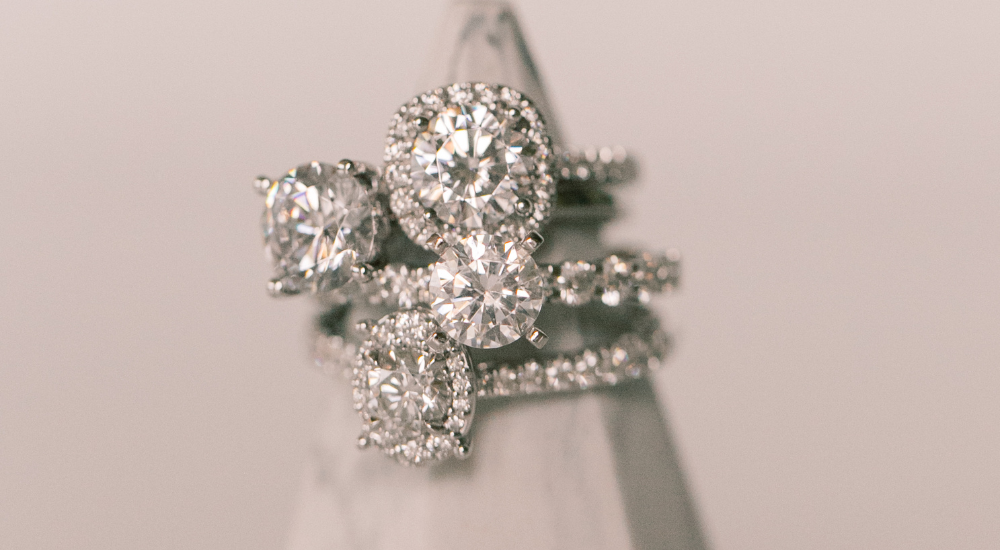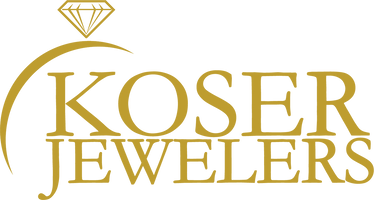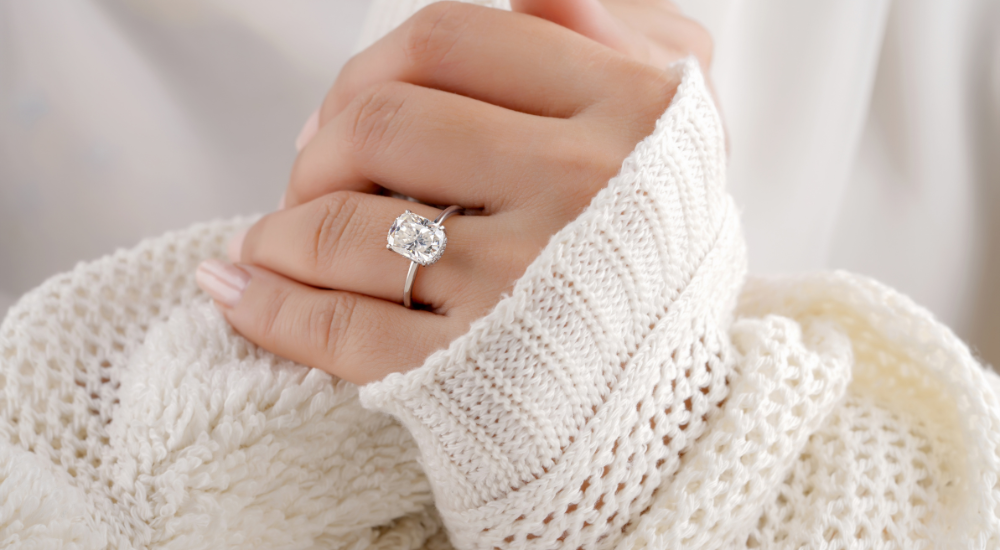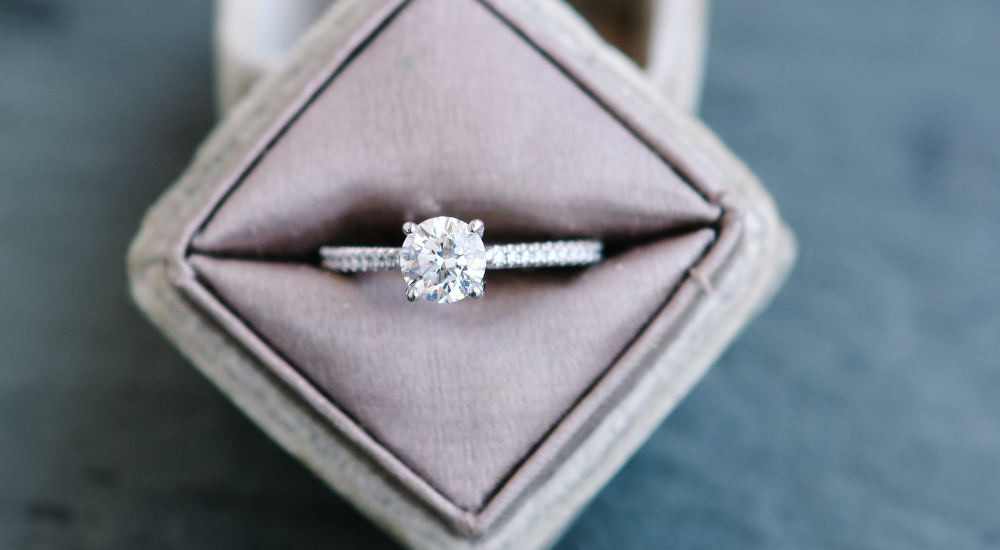Understanding Diamond Carat Weight

Understanding Diamond Carat Weight: A Comprehensive Guide
As you're shopping for a diamond — whether in an engagement ring or another piece of jewelry — you'll likely hear about the 4C's. Cut, color, clarity and carat all describe a diamond gemstone, but what does it all mean? In this guide, we'll explain diamond carat weight to help you in your search for the perfect piece of jewelry. You'll find everything from diamond carat meaning and its history to suggestions for selecting gemstone by carat here. Explore the guide below and learn more about this essential diamond quality.
Definition of Diamond Carat Weight
Before you purchase a diamond, it's essential to understand what carat means. The Gemological Institute of America (GIA) defines carat as the weight of a gemstone. If you ask a jeweler, "How much does a diamond weigh?" they'll respond in carats rather than grams or ounces. Diamond carat weight is divided into 100 points, like you see with dollars and cents, where 100 points equal 1 carat.
If a diamond weighs below 1 carat, the jeweler may describe it by points or cents. A 0.25-carat diamond may be referred to as a 25 pointer or as 25 cents. For a gemstone with a carat weight above one, you'll see carats and decimals. A jeweler will refer to a 1.25-carat diamond's weight as "one point 25 carats."
Diamond Carat Weight FAQs
Diamond carat weights play an important role in the look of your jewelry. As you browse, being familiar with how diamond carats work can help you understand the details of each jewelry piece and narrow down what you're looking for. The following are some frequently asked questions about diamond carat weight:
1. How Is a Diamond Carat Measured?
To find a diamond's carat weight, labs use a sensitive electronic scale known as a micro-balance. At GIA, these scales measure the stone's weight to the fifth decimal place for a more accurate reading.
In diamond reports, you often see carat weight measured to two decimal places if applicable. It's essential to look for diamonds with a weight given to two decimal points. A 0.97-carat diamond is different from a 1-carat diamond. That's reflected largely in price difference, especially when measuring the per-carat cost. Providing multiple decimal places indicates fair and accurate pricing.
2. How Much Does a Carat Diamond Weigh?
One carat weighs the same as 200 milligrams, which is equivalent to 0.2 grams or 0.007 ounces. That means a 5-carat diamond weighs 1 gram. Since even larger-sized diamonds are relatively lightweight, it's likely diamond carat weight will mostly affect the jewelry's look and price. The physical weight of a ring or necklace will depend on the jewelry's setting and other components.
3. Where Did Carat Weight Come From?
The history of this diamond measurement unit spans back to early gem traders. Before weight scales were common, balance scales compared the weights of two objects. Gem traders used the carob seed to compare with gemstones and find their weight. The carob seed comes from the flowering evergreen carob tree. The seeds were uniform in size — around 0.197 grams on average — making them as accurate of a comparison as possible with balance scales.
The carat measurement we have today as a result of early carob seed measurement maintains accuracy and consistency. Every corner of the world uses carats as a diamond measurement unit. This ensures that no matter where you see a diamond, it's measured to a recognizable standard.
4. What Is the Difference Between Carat and Karat?
When you're jewelry shopping, you might see the words carat and karat. So what's the difference? While carat weight is associated with gemstones, karat applies to gold. It represents the purity of gold alloys in jewelry out of 24 parts. That means 24-karat gold is the purest you can get, while something like 18-karat gold is 75% gold and 25% other alloys. You could, for instance, find gold jewelry described as having 18-karat gold and a 1-carat diamond.
5. What Is Total Carat Weight?
If you're looking for diamond jewelry instead of loose gemstones, you may encounter total carat weight. This quality comes with rings or jewelry that feature multiple diamonds, where total carat weight includes the diamond and diamond accents. If the center stone's setting has a halo of diamonds around it, the total carat weight will factor in the diamonds in the halo. The jewelry's information should still include the carat weight of the center stone on its own.
Diamond Carat Price FAQs
The weight of a diamond is closely tied to its price. Understanding this relationship can help you establish an ideal weight and price point based on the style of jewelry you'd like and your budget. The following are frequently asked questions about diamond carat prices:
1. How Does Carat Affect a Diamond's Price?
In general, a diamond with a larger carat weight will have a higher cost. Exceptionally large gemstones will have an even higher cost because they are rare. But every aspect of the 4C's contributes to a gemstone's price. If the cut, clarity and color of a diamond are the same, a higher carat means a higher price.
If you were to find a diamond with a brilliant cut, nearly perfect clarity and white color but a smaller carat weight, the price would reflect the near-perfect qualities. That stone could cost the same, if not more, than a diamond with inclusions, a yellow color and higher carat weight.
Certain diamond carat weights are considered "magic sizes." At these boundaries, you may see significantly higher prices per carat, all else being equal. GIA explains that the magic sizes correlate with popular weights. Popularity means more demand, and more demand means higher prices. The magic sizes occur at these intervals:
- Half carat
- Three-quarter carat
- One carat
This essentially means that when a diamond passes the magic size threshold, it will be more expensive. A diamond that weighs 1.06 carats will have a higher cost than one that weighs 0.99 carats if all other qualities are the same.
2. How Much Does the Average 1 Carat Diamond Cost?
Average diamond carat prices vary greatly with a diamond's other qualities. The shape, cut, color and clarity factor into the average 1-carat diamond price. Consider a round, excellent cut diamond. With a weight of 1 carat, that stone could cost anywhere around $2,000 to $16,000. A pure 1-carat diamond will be on the higher end of that price range. Remember, that price range is for a loose diamond. As you add a setting and jewelry, the price will go up accordingly. You could also find 1-carat diamonds that fall below those averages.
3. How Do You Compare Diamonds Using Per-Carat Cost?
If you decide to purchase a loose diamond for an engagement ring or jewelry setting, you may be comparing your options. In that case, you'll compare diamonds using a per-carat cost. To calculate the per-carat value, you divide the price of the stone by its carat weight. That gives you the per-carat cost and makes it easier to compare diamonds of different weights.
When you compare gemstones based on cost per carat, you want consistent standards. To get an accurate comparison between loose diamonds, you should compare diamonds that:
- Are graded by the same lab: Different laboratories could have varying standards or measuring and grading processes. You can't compare two diamonds if they have entirely differing descriptors, even though carats are a standard diamond measurement unit.
- Have the same shape and cut: Diamond shapes and cuts require great skill to execute, but certain shapes are more intricate than others. Extra work and time put into a diamond's shape will impact the per-carat cost. Different cuts create a more brilliant diamond, and that makes a more valuable stone. Compare diamonds with the same shape and cut for the most accurate comparison.
- Have similar color and clarity: Color and clarity are natural factors, making every gemstone unique. While no two diamonds are the same, they can receive the same grade on scales for color and clarity. Try to compare two diamonds that receive similar grades for these aspects of the 4C's for a clearer comparison.
What's the Difference Between Diamond Carat Weight and Stone Size?
While a diamond's carat weight and size are relative, they are not the same measurements. A diamond stone size refers to its specific dimensions, while carat is how much the stone weighs.
Gemstone graders use a scale to measure a diamond's weight and an optical measuring device for the different measurements, proportions and angles of the facets. On a GIA report, you'll see a stone's measurements in their own section. For round diamonds, the numbers represent the minimum diameter, maximum diameter and the depth. If you have something other than a round gemstone, called fancy-shaped diamonds, the measurements are the length, width and depth. The carat weight will be listed as such with how much your diamond weighs.
Of course, a diamond's weight doesn't always mean it will appear to be a certain size. This is where the other 4C's factor in along with various qualities of the jewelry. As you look at a diamond, its size could appear larger or smaller in relevance to its carat weight based on:
- Cut: The stone's cut can give the illusion of a larger or smaller stone size. The cut grade describes how a stone's facets catch and reflect light. If a diamond reflects light well with a quality cut and plenty of facets, it could seem larger. A poorly cut gemstone may end up hiding more of the stone once it's set in jewelry. A round diamond's girdle, or the area between the crown and the pavilion, could be cut too thick. A thicker girdle will create the appearance of a smaller diamond, even with a higher carat weight.
- Shape: A diamond's shape has a role in how large it looks, as well. This trait is different from the cut as it describes the form the gemcutter cuts the stone into. Elongated shapes, like marquise or pear shapes, may look larger than round or square diamonds of the same carat weight.
- Setting: The way a diamond is set in a ring impacts its perceived size. A halo setting that encircles the center stone in smaller diamonds gives the appearance of a larger gemstone. A cathedral setting that holds the stone off the band could also make the diamond look larger. That setting shows off more of the stone and helps it catch more light, appearing bigger and more dazzling.
What Carat Size Should a Diamond Engagement Ring Be?
According to The Knot, the average size for engagement rings in 2019 was between 1 carat and 1.5 carats. That doesn't mean you need to propose with a diamond engagement ring that falls within those sizes, though. As you consider what carat size your diamond engagement ring should be, factor in:
- Your budget: Because diamond carat weight influences the price, consider your budget as you decide on a carat size. If your budget is tight, consider a stone that falls a bit below a magic size. A 0.99-carat gemstone could cost less than a 1-carat one but look almost identical.
- Your partner's tastes: Some prefer a large or large-appearing diamond on their jewelry. Others prefer to be more subtle. Talk with your partner about their preferences for diamond size to have an idea of what to get. If you're engagement ring shopping and want it to be a surprise, talk with your partner's family or friends or trust your judgment of their tastes.
- You and your partner's priorities: As you search for an engagement ring, think about which of the 4C's will be a priority. Most individuals don't put carat weight at the top of their concerns. Instead, the cut, color and clarity take precedence. You and your partner may want to decide whether to get a rarer, nearly white diamond, a brilliant cut gemstone or one with few inclusions.
If your partner has a particular preference for a carat size but your budget is tight, compromise with the other 4C's. Get a diamond with a few, more subtle inclusions or internal markings. You can also get a diamond that's more yellow than pure white, which is a common trait of these gemstones anyway.
Choose a Jeweler You Trust to Help You Find the Perfect Diamond Jewelry
Ready to find the perfect engagement ring or a diamond jewelry gift for someone special? Choose a jeweler you trust and shop with Koser Jewelers. We buy diamonds based on beauty, not grading reports, which means you'll get the most beautiful and bright gemstone for your dollar when you shop with us. More than a dazzling stone, you'll also get exceptional service. Our caring and helpful staff will make sure you find the perfect engagement ring or diamond jewelry.
Contact us today with any questions about finding the perfect piece of jewelry for someone special. Take a look at our diamond engagement rings or browse our selection of stunning diamond earrings, pendants and bracelets. Speak without words with a showstopping diamond piece from Koser Jewelers!



